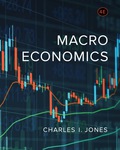
(a)
The ratio of per capita GDP relative to Country U’s steady state.
(a)
Explanation of Solution
The Solow economy is a steady state economy where the level of investment and the level of
In the case of Country U and Country S, the ratio of per capita GDP can be calculated when there is no change in TFP or in the rate of depreciation across countries. The key equation used in this case is as follows:
The value of the depreciation and TFP does not change and that means the only value and changes will be the investment rates for the two economies. The equation can be enlarged as follows:
It is identified that Country S has more investment than Country U, and it means that Country S would be richer than Country U. The difference in the per capita GDP between Countries U and S is calculated to be 14.1 percent than Country U’s level. Similarly, the difference between Country U and all other countries can be calculated and the table can be completed as follows:
| Country | Investment rate | Ratio of per capita GDP relative to Country U in steady state (percent) |
| US | 24.7 | - |
| Switzerla | 32.1 | 14.1 |
| Hokong | 26.2 | 3.1 |
| Fran | 25.0 | 0.6 |
| Jap | 29.0 | 8.3 |
| South Kore | 35.0 | 19.0 |
| Argentin | 16.0 | -19.5 |
| Mexic | 21.1 | -9.2 |
| Thailan | 26.4 | 3.4 |
| Indi | 23.3 | -2.9 |
| Keny | 11.1 | -33.3 |
| Ethiopi | 10.4 | -36.4 |
(b)
The ratio of per capita GDP relative to Country U’s steady state with TFP differences.
(b)
Explanation of Solution
When there is difference in TFP of the economy, the equation would change as follows:
It is identified that Country S has more TFP than Country U, and it means that Country S would push the steady-state level higher than Country U’s level by 18 percent. Similarly, the difference between Country U’s and all other countries can be calculated and the table can be completed as follows:
| Country | Investment rate | TFP | Ratio of per capita GDP relative to Country U in steady state with TFP differences (percent) |
| US | 24.7 | 1.000 | - |
| Switzerla | 32.1 | 1.022 | 17.8 |
| Hokong | 26.2 | 0.835 | -13.0 |
| Fran | 25.0 | 0.688 | -34.9 |
| Jap | 29.0 | 0.680 | -36.0 |
| South Kore | 35.0 | 0.711 | -31.7 |
| Argentin | 16.0 | 0.534 | -55.6 |
| Mexic | 21.1 | 0.438 | -67.1 |
| Thailan | 26.4 | 0.381 | -73.2 |
| Indi | 23.3 | 0.240 | -80.3 |
| Keny | 11.1 | 0.178 | -91.4 |
| Ethiopi | 10.4 | 0.102 | -96.3 |
(c)
The percentage gap between the steady-state income ratio and the ratio in 2014.
(c)
Explanation of Solution
The income ratio of Country S is 114.7 percent, whereas the steady-state level with TFP differences is 117.8. Therefore, the gap between the current position and the steady state position can be calculated as follows:
Thus, it shows that Country S is slightly below its steady state position. Similarly, the gap between the current and the steady state position for other countries can be calculated and tabulated as follows:
| Country | Investment rate | TFP | Ratio of per capita GDP relative to US in steady state (percent) | Ratio of per capita GDP relative to US in steady state with TFP differences (percent) | Gap between current and steady state level |
| US | 24.7 | 1.000 | - | - | - |
| Switzerla | 32.1 | 1.022 | 14.1 | 17.8 | 2.70 |
| Hokong | 26.2 | 0.835 | 3.1 | -13.0 | -15.62 |
| Fran | 25.0 | 0.688 | 0.6 | -34.9 | -35.23 |
| Jap | 29.0 | 0.680 | 8.3 | -36.0 | -40.90 |
| South Kore | 35.0 | 0.711 | 19.0 | -31.7 | -42.61 |
| Argentin | 16.0 | 0.534 | -19.5 | -55.6 | -44.84 |
| Mexic | 21.1 | 0.438 | -9.2 | -67.1 | -63.77 |
| Thailan | 26.4 | 0.381 | 3.4 | -73.2 | -74.08 |
| Indi | 23.3 | 0.240 | -2.9 | -80.3 | -79.71 |
| Keny | 11.1 | 0.178 | -33.3 | -91.4 | -87.11 |
| Ethiopi | 10.4 | 0.102 | -36.4 | -96.3 | -94.18 |
(d)
The countries ranked based on the transition dynamics.
(d)
Explanation of Solution
The countries that have higher differences between the current state and the steady-state level would grow faster and when the countries reach close to their steady-state level, the economic growth would be slower and slower. This is suggested by the transition dynamics in the economy. The ranking will be in reverse order, which means that the economy with the highest growth rate will be Country E and least growth will be Country U.
Want to see more full solutions like this?
Chapter 5 Solutions
EBK MACROECONOMICS (FOURTH EDITION)
- 2. Answer the following questions as they relate to a fishery: Why is the maximum sustainable yield not necessarily the optimal sustainable yield? Does the same intuition apply to Nathaniel's decision of when to cut his trees? What condition will hold at the equilibrium level of fishing in an open-access fishery? Use a graph to explain your answer, and show the level of fishing effort. Would this same condition hold if there was only one boat in the fishery? If not, what condition will hold, and why is it different? Use the same graph to show the single boat's level of effort. Suppose you are given authority to solve the open-access problem in the fishery. What is the key problem that you must address with your policy?arrow_forward1. Repeated rounds of negotiation exacerbate the incentive to free-ride that exists for nations considering the ratification of international environmental agreements.arrow_forwardFor environmental Economics, A-C Pleasearrow_forward
- True/ False/ Undetermined - Environmental Economics 3. When the MAC is known but there is uncertainty about the MDF, an emissions quota leads to a lower deadweight loss associated with this uncertainty.arrow_forwardTrue/False/U- Environmental Economics 2. The discount rate used in climate integrated assessment models is the key driver of the intensity of emissions reductions associated with optimal climate policy in the model.arrow_forwardAt the beginning of the year, the market for portable electric fans was in equilibrium. In June, a summer heat wave hit. What effect does the heat wave have on the market for fans? Drag the appropriate part(s) of the graph to show the effect on the market for portable fans. To refer to the graphing tutorial for this question type, please click here. Price 17 OF 21 QUESTIONS COMPLETED f4 Q Search f5 f6 f7 CO hp fg 6 M366 W ins f12 f11 f10 SUBMIT ANSWER ENG 4xarrow_forward
- In the context of investment risk, what does "diversification" mean? A) Spreading investments across various assets to reduce riskB) Investing in a single asset to maximize returnsC) Increasing investment in high-risk assetsD) Reducing the number of investments to focus on high-performing onesarrow_forwardAt the 8:10 café, there are equal numbers of two types of customers with the following values. The café owner cannot distinguish between the two types of students because many students without early classes arrive early anyway (that is she cannot price discriminate). Students with early classes Students without early classes Coffee 70 60 Banana 50 100 The MC of coffee is 10. The MC of a banana is 40. Is bundling more profitable than selling separately? HINT: if you sell the bundle, can you make more by offering coffee separately? If so, what price should be charged for the bundle? (Show calculations)arrow_forwardYour marketing department has identified the following customer demographics in the following table. Construct a demand curve and determine the profit maximizing price as well as the expected profit if MC=$1. The number of customers in the target population is 10,000. Use the following demand data: Group Value Frequency Baby boomers $5 20% Generation X $4 10% Generation Y $3 10% `Tweeners $2 10% Seniors $2 10% Others $0 40%arrow_forward
- Your marketing department has identified the following customer demographics in the following table. Construct a demand curve and determine the profit maximizing price as well as the expected profit if MC=$1. The number of customers in the target population is 10,000. Group Value Frequency Baby boomers $5 20% Generation X $4 10% Generation Y $3 10% `Tweeners $2 10% Seniors $2 10% Others $0 40% ur marketing department has identified the following customer demographics in the following table. Construct a demand curve and determine the profit maximizing price as well as the expected profit if MC=$1. The number of customers in the target population is 10,000.arrow_forwardTest Preparation QUESTION 2 [20] 2.1 Body Mass Index (BMI) is a summary measure of relative health. It is calculated by dividing an individual's weight (in kilograms) by the square of their height (in meters). A small sample was drawn from the population of UWC students to determine the effect of exercise on BMI score. Given the following table, find the constant and slope parameters of the sample regression function of BMI = f(Weekly exercise hours). Interpret the two estimated parameter values. X (Weekly exercise hours) Y (Body-Mass index) QUESTION 3 2 4 6 8 10 12 41 38 33 27 23 19 Derek investigates the relationship between the days (per year) absent from work (ABSENT) and the number of years taken for the worker to be promoted (PROMOTION). He interviewed a sample of 22 employees in Cape Town to obtain information on ABSENT (X) and PROMOTION (Y), and derived the following: ΣΧ ΣΥ 341 ΣΧΥ 176 ΣΧ 1187 1012 3.1 By using the OLS method, prove that the constant and slope parameters of the…arrow_forwardQUESTION 2 2.1 [30] Mariana, a researcher at the World Health Organisation (WHO), collects information on weekly study hours (HOURS) and blood pressure level when writing a test (BLOOD) from a sample of university students across the country, before running the regression BLOOD = f(STUDY). She collects data from 5 students as listed below: X (STUDY) 2 Y (BLOOD) 4 6 8 10 141 138 133 127 123 2.1.1 By using the OLS method and the information above derive the values for parameters B1 and B2. 2.1.2 Derive the RSS (sum of squares for the residuals). 2.1.3 Hence, calculate ô 2.2 2.3 (6) (3) Further, she replicates her study and collects data from 122 students from a rival university. She derives the residuals followed by computing skewness (S) equals -1.25 and kurtosis (K) equals 8.25 for the rival university data. Conduct the Jacque-Bera test of normality at a = 0.05. (5) Upon tasked with deriving estimates of ẞ1, B2, 82 and the standard errors (SE) of ẞ1 and B₂ for the replicated data.…arrow_forward
 Managerial Economics: Applications, Strategies an...EconomicsISBN:9781305506381Author:James R. McGuigan, R. Charles Moyer, Frederick H.deB. HarrisPublisher:Cengage Learning
Managerial Economics: Applications, Strategies an...EconomicsISBN:9781305506381Author:James R. McGuigan, R. Charles Moyer, Frederick H.deB. HarrisPublisher:Cengage Learning Economics Today and Tomorrow, Student EditionEconomicsISBN:9780078747663Author:McGraw-HillPublisher:Glencoe/McGraw-Hill School Pub Co
Economics Today and Tomorrow, Student EditionEconomicsISBN:9780078747663Author:McGraw-HillPublisher:Glencoe/McGraw-Hill School Pub Co








